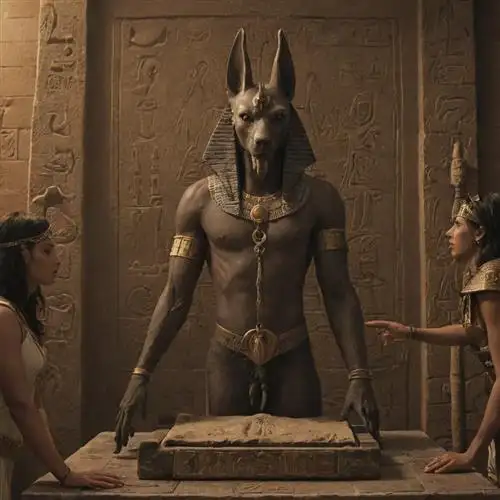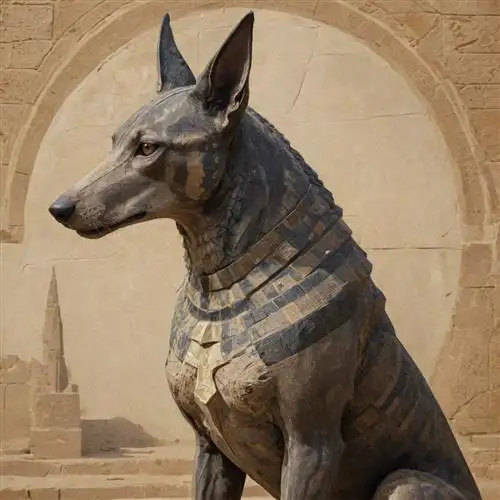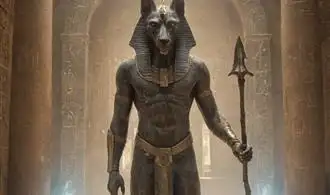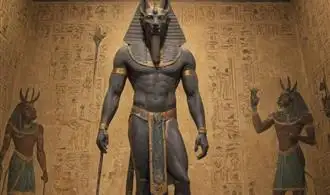
The Enigmatic Canine Deity
Anubis, the enigmatic jackal-headed deity, has captivated the hearts and minds of those fascinated by ancient Egyptian mythology. This canine deity's multifaceted symbolism and enigmatic nature have long been the subject of scholarly discourse and public intrigue. Delving into the depths of Anubis's symbolism unveils a tapestry of profound insights that shed light on the ancient Egyptians' conceptions of the afterlife, death, and the divine.
At the core of Anubis's iconography lies the jackal, a creature deeply revered and associated with the necropolis in ancient Egypt. The jackal's nocturnal nature, keen senses, and ability to traverse the boundary between the living and the dead, made it a fitting symbol for Anubis, the god who presided over the embalming process and guided the deceased through the treacherous journey of the afterlife.
Anubis's role as the "Opener of the Ways" was crucial in the Egyptian funerary rites, where he would oversee the mummification of the deceased and ensure their successful transition into the afterlife. This duty was not merely a practical one; it was imbued with profound spiritual significance, as Anubis was believed to possess the knowledge and power to facilitate the deceased's journey through the underworld, guiding them past the hazards and obstacles that awaited them.
The jackal-headed deity's association with death and the afterlife, however, does not diminish the breadth of his symbolic meaning. Anubis was also revered as a protector, a guardian of the dead, and a symbol of transformation and rebirth. His presence in the embalming process and his role in the weighing of the heart ceremony, where the deceased's heart was weighed against the feather of Ma'at (the goddess of truth and justice), solidified his position as a central figure in the Egyptian conception of the afterlife.
Intriguingly, Anubis's canine features also hint at a deeper connection to the natural world and the cyclical nature of life and death. The jackal's ability to thrive in the harsh desert environment, scavenging and adapting to the challenges of the land, may have contributed to Anubis's association with the regenerative power of nature and the inevitability of the cycle of life and death.
Moreover, the striking duality of Anubis's character, as both a protector and a harbinger of death, reflects the ancient Egyptians' profound understanding of the delicate balance between life and death, light and darkness, and the essential role of the divine in maintaining this equilibrium. Anubis's dual nature, encompassing both the comforting and the unsettling aspects of death, serves as a powerful metaphor for the human experience of mortality and the mysteries that lie beyond the veil of the physical world.
The Guardian of Mummification
Anubis, the jackal-headed deity, was a revered figure in ancient Egyptian mythology, playing a crucial role in the process of mummification and the afterlife. As the Guardian of Mummification, Anubis was responsible for the intricate process of preserving the deceased, ensuring their safe passage to the next life. This unique role granted Anubis a profound symbolic significance, making him an integral part of the ancient Egyptian belief system.
At the heart of Anubis' responsibility as the Guardian of Mummification was the delicate and meticulous process of preparing the deceased for their eternal journey. Anubis was believed to oversee the entire mummification process, from the initial removal of the internal organs to the wrapping of the body in layers of linen. This ritual was not only a practical necessity but also held deep spiritual meaning, as the preserved body was seen as a vessel for the soul to reside in the afterlife.
Anubis' presence during the mummification process was believed to be essential, as he was responsible for guiding the soul of the deceased through the challenges of the afterlife. The jackal-headed deity was often depicted standing guard over the mummified body, ensuring that the transformation from mortal to immortal was complete. This symbolic role was further reinforced by the placement of Anubis statues and images within the burial chambers, serving as a constant reminder of his protective presence.
Moreover, Anubis' association with mummification and the afterlife extended beyond the physical realm. He was also believed to preside over the weighing of the heart ceremony, a crucial step in the judgment of the deceased. In this ritual, the heart of the deceased was weighed against the feather of truth, and Anubis was responsible for guiding the soul through this pivotal moment, ensuring a successful transition to the afterlife.
The Psychopomp and the Afterlife
Anubis, the enigmatic jackal-headed deity of ancient Egypt, has long captivated the imagination of scholars and enthusiasts alike. As a psychopomp, or a guide of souls to the afterlife, Anubis played a pivotal role in the Egyptian conception of the afterlife. This article delves into the intriguing symbolism associated with Anubis and his connection to the realm beyond the mortal coil.
The role of Anubis as a psychopomp was of utmost significance in the Egyptian funerary rites. He was believed to be responsible for the crucial process of mummification, ensuring the preservation of the physical body. This meticulous preparation of the deceased was essential, as it was thought to facilitate the soul's safe passage to the afterlife. Anubis would then guide the soul through the dangerous and treacherous journey, protecting it from the perils that lay in wait.
The jackal-headed deity's association with the afterlife extended beyond his role as a psychopomp. Anubis was also believed to preside over the weighing of the heart ceremony, a pivotal moment in the judgment of the deceased. During this ritual, the heart of the deceased was weighed against the feather of Ma'at, the goddess of truth and justice. If the heart was found to be pure, the soul would be granted passage to the afterlife. Anubis, as the guardian of this process, ensured the fairness and accuracy of the weighing, guiding the soul to its rightful destination.
The symbolic significance of Anubis's jackal-like appearance has been the subject of much scholarly debate. The jackal was believed to be a creature that haunted the edges of the desert, the realm of the dead, and thus Anubis's association with this animal further cemented his role as a guide to the afterlife. Moreover, the jackal's keen senses and ability to navigate the treacherous landscape of the desert were seen as attributes that made Anubis well-equipped to shepherd the souls of the deceased through the challenges of the afterlife.
Anubis's importance in the Egyptian pantheon is further underscored by his presence in the 4 Unusual Insights into the Symbolism of Anubis Images. These visual representations of the deity provide a deeper understanding of his multifaceted role and the reverence with which he was held by the ancient Egyptians.
The Weighing of the Heart
In ancient Egyptian mythology, the Weighing of the Heart was a critical stage in the afterlife journey, presided over by the jackal-headed deity Anubis. This ritual held immense significance, as it determined the fate of the deceased, shaping their transition into the next realm.
Anubis, revered as the god of embalming and the protector of the dead, played a pivotal role in this sacred ceremony. Upon the death of an individual, the heart – considered the seat of the soul in Egyptian belief – was carefully removed and placed on one side of a scale, with the Feather of Ma'at, representing truth and justice, on the other.
The deceased's actions and deeds during their lifetime were then meticulously scrutinized. If the heart balanced evenly with the Feather of Ma'at, the individual was deemed worthy and allowed to pass into the afterlife, where they would enjoy eternal bliss. However, if the heart was heavier, it was devoured by the monstrous demon Ammit, symbolizing the individual's moral failings and condemning them to eternal damnation.
The Weighing of the Heart ceremony was more than just a judgment of the deceased; it was a profound reflection on the values and principles that guided one's life. It emphasized the importance of living a virtuous, truthful, and balanced existence, as the consequences in the afterlife were believed to be severe.
Anubis, as the overseer of this ritual, was endowed with immense responsibility and authority. His presence ensured the fairness and integrity of the proceedings, as he meticulously observed the weighing and recorded the results. The jackal-headed deity's role in this process solidified his status as a gatekeeper to the afterlife, guiding the worthy and rejecting the unworthy.
The Duality of Anubis
Anubis, the enigmatic Egyptian god, is a complex and multifaceted deity whose symbolism extends far beyond the realm of the afterlife. One of the most intriguing aspects of Anubis is his inherent duality, a characteristic that has captivated scholars and enthusiasts alike.
At the core of Anubis' duality lies his role as both a protector and a guide. On one hand, Anubis is the guardian of the dead, responsible for ensuring the proper preparation and preservation of the deceased. He oversees the mummification process, a sacred ritual that was believed to facilitate the transition from the physical world to the afterlife. In this capacity, Anubis is a symbol of transition, guiding the soul through the perilous journey to the next life.
On the other hand, Anubis is also associated with judgment and the weighing of the heart. In the ancient Egyptian afterlife, it was believed that the heart of the deceased would be weighed against the feather of Ma'at, the goddess of truth and justice. Anubis, as the god of the dead, was responsible for overseeing this crucial process, ensuring the deceased had lived a virtuous life. This aspect of Anubis' role reflects his capacity for impartiality and his role as a gatekeeper to the afterlife.
The duality of Anubis is further manifested in his physical appearance. Typically depicted with the head of a jackal or a dog, Anubis is a liminal figure, existing between the realms of the living and the dead. The jackal, an animal known for its scavenging nature and its ability to thrive in both the desert and the city, is a fitting representation of Anubis' dual nature. The jackal's association with death and decay, as well as its adaptability, perfectly encapsulate the multifaceted role of Anubis in Egyptian mythology.
Moreover, Anubis' duality extends to his relationship with other deities. While he is primarily associated with the god Osiris, the ruler of the underworld, Anubis also shares a complex relationship with the goddess Isis. Isis, as the sister and wife of Osiris, played a crucial role in the resurrection and regeneration of the dead, a process in which Anubis was an integral participant.















